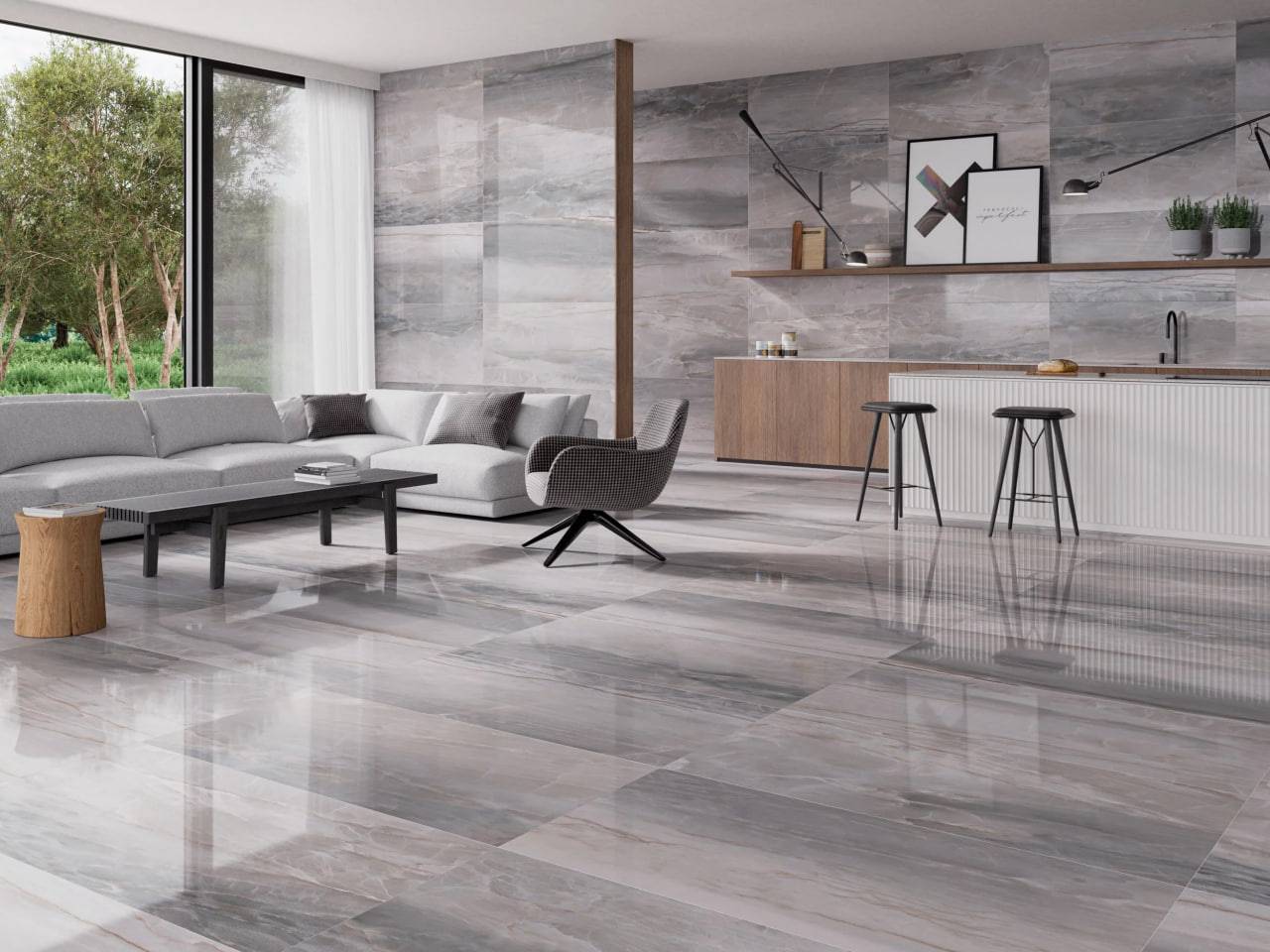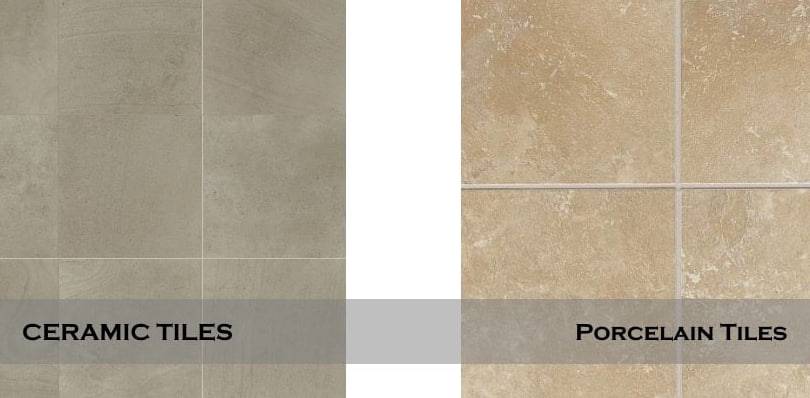Tile adds beauty and durability to your home, but with two popular options like porcelain and ceramic tile, deciding between them can be tricky. While both belong to the “ceramic” family, they offer distinct advantages and drawbacks.
The main difference lies in their water absorption rate. Porcelain boasts an impressive near-impermeability, absorbing less than 0.5% of water, making it ideal for high-moisture areas like bathrooms and outdoor spaces. This superior water resistance comes with industry-accepted certifications, ensuring peace of mind.
Porcelain’s water-resistant prowess stems from its finer composition. The use of high-quality kaolin clay and higher firing temperatures creates a denser, less porous tile. However, this enhanced quality comes at a cost, making porcelain generally more expensive than its ceramic counterpart.
Stay tuned as we explore the pros and cons of each type, helping you navigate the world of tile and choose the perfect option for your needs and budget.
| Feature | Porcelain | Ceramic |
|---|---|---|
| Composition | Fine kaolin clay | Earthen clays |
| Water Absorption | < 0.5% | > 0.5% |
| Location | High-moisture areas (bathrooms, outdoors) | Low-moisture areas (living rooms, kitchens) |
| Hardness | High | Moderate |
| Body Water Resistance | Impervious | Resistant |
| Top Water Resistance | Requires sealant | May require sealant |
Porcelain Tile: A Deep Dive into Its Unique Qualities
Imagine a tile that’s denser, smoother, and tougher than your usual ceramic counterpart. That’s porcelain tile, a champion in water resistance thanks to its unique composition and intense firing process.
Key characteristics:
- Finer clay blend: Porcelain uses kaolin clay, known for its purity and density, often mixed with quartz and feldspar for added strength.
- High-heat treatment: Fired at scorching temperatures (2,200-2,500°F), porcelain becomes incredibly dense and virtually impervious to water absorption.
- Outdoor potential: This water resistance makes it ideal for outdoor use in mild climates, but always double-check manufacturer specifications for suitability.
Testing for top-tier water resistance:
- Certification: Look for the PTCA Certification Mark, a guarantee of low water absorption (less than 0.5%).
- The boiling test: Imagine boiling a tile for five hours! If it gains minimal weight after, it’s truly water-resistant porcelain.
Things to consider:
- Cost: Be prepared to pay more compared to ceramic tiles due to their premium qualities and limited production (only 21 companies offer porcelain).
- Selection: The variety of porcelain designs is smaller than the vast ceramic category, so keep your specific aesthetic preferences in mind.
Ceramic Tile: More Affordable, But Not as Forgiving
- Clay-based charm: Ceramic tile offers a classic charm, crafted from heat-treated clay and often protected by a glossy glaze. It’s a versatile choice for many areas of your home.
- A coarser composition: Compared to its porcelain cousin, ceramic uses a clay mix with less kaolin, resulting in a slightly rougher texture. While it still boasts some kaolin, the overall blend lacks the additional strengthening additives found in porcelain.
- Lower firing temperatures: The firing process for ceramic tile happens at a cooler temperature (1,800-2,000°F) compared to porcelain. This impacts several key aspects of the tile.
- Moisture susceptibility: The lower firing temperature makes ceramic tile more prone to moisture absorption. However, the glazed surface acts as a barrier, repelling water as long as it remains intact. However, unglazed areas like the back or sides are vulnerable to water infiltration.
- Cost-effective choice: One significant advantage of ceramic tile is its affordability. The lower firing temperatures translate to lower production costs, making it 30-40% cheaper than porcelain.
Unveiling the Mystery: Telling Porcelain from Ceramic Tile
Distinguishing porcelain and ceramic tile can be tricky, as they often wear the same glazed disguise! But fear not, there are ways to unveil their true identities:
The Certification Clue:
- Porcelain: Look for the PTCA Certification Mark: a green and gray logo with “Certified Porcelain Tile 0.5% Water Absorption” and a diamond-shaped tile forming the “O” in “porcelain.” You can also check The Porcelain Tile Certification Agency’s list of certified product lines for extra assurance.
- Ceramic: Unfortunately, ceramic tiles lack a similar visual identifier.
Beyond the Mark:
While the certification mark is the most reliable indicator, there are other subtle clues:
- Sound Test: Tap both tiles gently. Porcelain usually produces a clearer, higher-pitched sound than ceramic, which might sound duller.
- Weight: Porcelain is denser, so it might feel slightly heavier than a comparable-sized ceramic tile.
- Edge Inspection: The edges of unglazed porcelain tiles typically show the same color throughout, while ceramic might reveal a different-colored core beneath the glaze.
Remember: Don’t trust manufacturer claims blindly! A study found that nearly 25% of tiles labeled as “impervious porcelain” absorbed significantly more water than allowed, exceeding the maximum by up to six times.
Heat & Water Resistance: A Tale of Two Tiles
Standing Up to the Heat:
Both porcelain and ceramic tile can handle heat like champs, making them countertop contenders. But when it comes to water, their stories diverge.
Porcelain: The Water Warrior:
Porcelain boasts impressive water resistance, absorbing less than its ceramic counterpart. This makes it a viable option for outdoor use in mild climates, adding a touch of elegance to patios and walkways.
Ceramic: Not So Fond of Floods:
Ceramic tile, while not a water enthusiast, holds its own in low-moisture areas. However, outdoor adventures are best left to its porcelain cousin. Remember, keeping it dry is key to its long-lasting beauty.
Cleaning & Care: Keeping Them Sparkling
The good news? Both tile types enjoy the same simple cleaning routine:
- Sweep or vacuum regularly: Banish grit and dirt twice a week to protect the glaze.
- Damp-mop bi-weekly: Use a mild water-soap solution to keep the shine alive.
- Bathroom vigilance: Pay extra attention to bathroom tiles. Mold and mildew in grout seams are no match for regular cleaning and proper ventilation.
Remember: While both tiles offer durability, porcelain reigns supreme in water resistance. Choose wisely based on your needs and enjoy the timeless beauty they bring to your home!
Comparing the Toughness: Porcelain vs. Ceramic Tile
Durability:
- Porcelain: The denser clays make it harder and less prone to chipping, but also more brittle and susceptible to cracking. Think of it as the strong but stoic warrior.
- Ceramic: Less dense, so slightly more vulnerable to cracks and breaks. Imagine it as the flexible but slightly more delicate acrobat.
Maintenance:
- Both: Unsanded grout needs regular sealing to prevent stains and mildew.
- Porcelain: More impervious to moisture, so requires less frequent sealing.
- Ceramic: Unglazed tiles might need additional sealing on the entire surface.
Installation:
- Both: Same installation process using mortar and wet tile saw (recommended for porcelain due to its brittleness).
Summary:
Porcelain wins in terms of water resistance and chip resistance, but is more brittle. Ceramic is slightly more flexible but needs more frequent sealing and care if unglazed. Ultimately, the choice depends on your priorities:
- Go for porcelain if: You need superior water resistance, durability against chips, and are comfortable with a more brittle material.
- Choose ceramic if: You prioritize a more flexible option, don’t mind frequent grout sealing, and have areas with less moisture exposure.
Remember, both tiles offer beauty and functionality, so the best choice depends on your specific needs and preferences.
So, Porcelain or Ceramic? The Final Showdown
While both porcelain and ceramic hold their own in many interior applications, choosing the right one for your needs isn’t as simple as just picking a name. Here’s the key takeaway:
Moisture Matters:
If you’re looking for a moisture-resistant champion, porcelain takes the crown. Its ability to withstand water makes it ideal for bathrooms, outdoor patios in mild climates, and high-traffic areas. However, remember, even porcelain isn’t invincible. Always check the manufacturer’s specifications for specific freeze/thaw suitability.
Durability Dance:
Need a super durable tile that rarely chips? Porcelain is your friend. However, its strength comes with a slight downside: it can be more brittle and prone to cracks. If you prioritize flexibility, ceramic might be your better match.
Budget Blues:
Looking for a cost-effective option? Ceramic usually wins the price battle. But remember, you might need to invest more in sealing and maintenance, especially for unglazed tiles.
The name “porcelain” isn’t a guarantee of freeze-thaw resistance. Always double-check the manufacturer’s specifications for specific application suitability.
Ultimately, the best choice depends on your unique needs and priorities. Consider the moisture level, durability requirements, and budget, and let this guide help you pick the perfect tile for your space!
Porcelain vs. Ceramic Tile: Your FAQs Answered
Q: Is porcelain tile more expensive than ceramic?
A: Absolutely! Expect to pay 30-40% more for porcelain’s superior qualities.
Q: Are porcelain tiles waterproof?
A: Not quite! They’re impervious, meaning they absorb minimal water according to strict testing standards. However, the glazed surface offers true waterproofing.
Q: Which tile reigns supreme for bathroom floors?
A: Porcelain takes the crown! Its water resistance makes it the champion for moisture-prone areas like bathrooms.
Q: Do porcelain tiles chip easily?
A: Not if installed well. Their density protects them from chips, but their inflexibility makes them more susceptible to cracks from structural shifts.
Q: Ceramic or porcelain for the kitchen floor?
A: Porcelain wins again! Its hardness and durability make it ideal for high-traffic areas like kitchens, plus it’s easy to clean and maintain.




